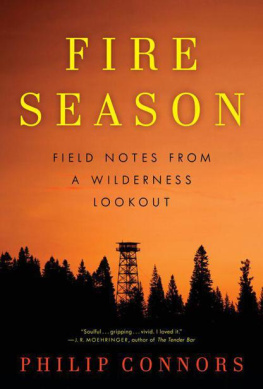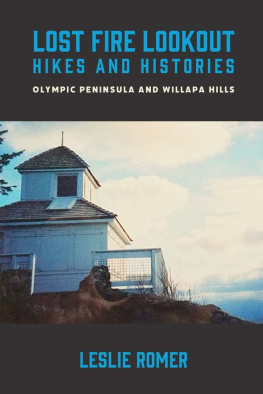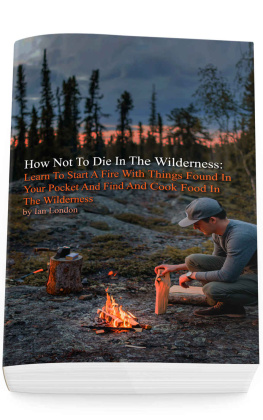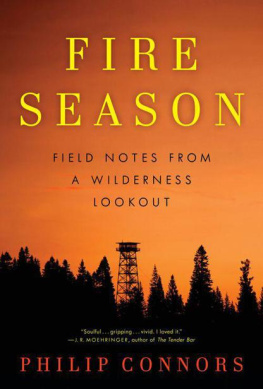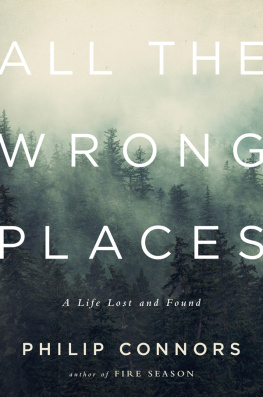Philip Connors - Fire Season: Field Notes from a Wilderness Lookout
Here you can read online Philip Connors - Fire Season: Field Notes from a Wilderness Lookout full text of the book (entire story) in english for free. Download pdf and epub, get meaning, cover and reviews about this ebook. year: 2011, publisher: HarperCollins Publishers, genre: Romance novel. Description of the work, (preface) as well as reviews are available. Best literature library LitArk.com created for fans of good reading and offers a wide selection of genres:
Romance novel
Science fiction
Adventure
Detective
Science
History
Home and family
Prose
Art
Politics
Computer
Non-fiction
Religion
Business
Children
Humor
Choose a favorite category and find really read worthwhile books. Enjoy immersion in the world of imagination, feel the emotions of the characters or learn something new for yourself, make an fascinating discovery.
- Book:Fire Season: Field Notes from a Wilderness Lookout
- Author:
- Publisher:HarperCollins Publishers
- Genre:
- Year:2011
- Rating:5 / 5
- Favourites:Add to favourites
- Your mark:
- 100
- 1
- 2
- 3
- 4
- 5
Fire Season: Field Notes from a Wilderness Lookout: summary, description and annotation
We offer to read an annotation, description, summary or preface (depends on what the author of the book "Fire Season: Field Notes from a Wilderness Lookout" wrote himself). If you haven't found the necessary information about the book — write in the comments, we will try to find it.
Fire Season: Field Notes from a Wilderness Lookout — read online for free the complete book (whole text) full work
Below is the text of the book, divided by pages. System saving the place of the last page read, allows you to conveniently read the book "Fire Season: Field Notes from a Wilderness Lookout" online for free, without having to search again every time where you left off. Put a bookmark, and you can go to the page where you finished reading at any time.
Font size:
Interval:
Bookmark:
Fire Season
Field Notes from a Wilderness Lookout
Philip Connors

For Martha
Contents
April
May
June
July
August
U ntil about fifteen years ago I thought fire lookouts had gone the way of itinerant cowboys, small-time gold prospectors, and other icons of an older, wilder West. Then a friend of mine named Mandijane asked for my mailing address in Missoula, Montana, where we were both students in print journalismone of the least timely courses of study in the history of higher education, though we couldnt have known that at the time. M.J. said shed soon have a lot of time to write letters. When spring exams were over, shed be off to New Mexico to watch for fires.
I was intrigued, and more than a little envious; M.J.s letters did not disappoint. She was posted in the middle of the Gila National Forest, on the edge of the worlds first designated wilderness, 130 miles north of the border with Mexico. On Loco Mountain, she said, not a single man-made light could be seen after dark. She lived in her lookout tower, a twelve-by-twelve-foot room on stilts. The nearest grocery store was five miles by pack trail and eighty-five more by mountain road. Over the course of four months she had fewer than twenty visitorshunters on horseback, mainly, and a few adventurous hikers. The romance in those letters was almost unimaginable.
For years our paths diverged, though we always kept in touch by letter. I left school for New York and lucked into a job with the Wall Street Journal . Her continuing adventures took her to Ghana, Costa Rica, and Argentina. One spring she wrote to say she was back in the States for another summer gig in the Gila, this time at a different tower forty miles southeast of Loco Mountain. She knew I was busy, tied to a desk in New York, but suggested I take a vacation and come see the country, for a few days at least.
I needed no further urging. Id already hustled too long and for no good purpose in the city, and when I finally looked out on that country with two dozen mountain ranges I couldnt name, more mountains than a person could hope to explore on foot in a lifetime, I guess you could say I fell in love at first sight. And what a sight it was: a stretch of country larger than the state of Maryland, nearly 20,000 square miles of desert and forest, sky island mountain chains in three states and two countries. In the afternoons, when M.J. sat in the tower keeping watch, I hiked through old-growth fir and massive groves of quaking aspen. I was unaware of it at the time, but those aspen had grown back in the scar of what was, for almost half a century, the biggest fire on record in the Southwest: the McKnight Fire of 1951, which burned 50,000 acres along the slopes of the Black Range. Much of the fire crowned in mature timber, creating a massive stand replacementthe death of one or several tree species and their total succession by others. Though I could not see it yet, Id been seduced on my walks by that fire, or at least by the effects of the fire, the beauty of the forest created in its wake.
Around our own little bonfire under starlight, M.J. told me shed grown antsy in the lookout. She wanted to get out on a fire, inhale the smoke, feel the heat of the flamesand make some bigger money, overtime and hazard pay. Her boss was game, she said, if she could find him someone reliable to take over fire watch. By the time I had to hike out and head home, Id talked myself into her job. Shed vouch for my backwoods bona fidesatrophied after four years in the cityand Id fly to New York, offer two weeks notice at work, and be back before the moon was full again. I knew almost nothing about being a lookout except what Id read in books, but what Id read seemed promising. It doesnt take much in the way of body and mind to be a lookout, Norman Maclean had written. Its mostly soul.
Since that first summer Ive returned each succeeding year to sit 10,000 feet above sea level and watch for smoke. Most days I can see a hundred miles in all directions. On clear days I can make out mountains 180 miles away. To the east stretches the valley of the Rio Grande, cradled by the desert: austere, forbidding, dotted with creosote shrubs, and home to a collection of horned and thorned species evolved to live in a land of scarce water. To the north and south, along the Black Range, a line of peaks rises and falls in timbered waves; to the west, the Rio Mimbres meanders out of the mountains, its lower valley verdant with grasses. Beyond it rise more mesas and mountains: the Diablos, the Jerkies, the Mogollons. A peaceable kingdom, a wilderness in good working orderand my job to sound the alarm if it burns.
Having spent eight summers in my little glass-walled perch, I have an intimate acquaintance with the look and feel of the border highlands each week of each month, from April through August: the brutal winds of spring, when gales off the desert gust above seventy miles an hour and the occasional snow squall turns my peak white; the dawning of summer in late May, when the wind abates and the aphids hatch and ladybugs emerge in great clouds from their hibernation; the fires of June, when dry lightning connects with the hills and mesas, sparking smokes that fill the air with the sweet smell of burning pine; the tremendous storms of July, when the radio antenna sizzles like bacon on a griddle and the lightning makes me flinch as if from the threat of a punch; and the blessed indolence of August, when the meadows bloom with wildflowers and the creeks run again, the rains having turned my world a dozen different shades of green. Ive seen lunar eclipses and desert sandstorms and lightning that made my hair stand on end. Ive seen fires burn so hot they made their own weather. Ive watched deer and elk frolic in the meadow below me and pine trees explode in a blue ball of smoke. If theres a better job anywhere on the planet, Id like to know what it is.
The work has changed remarkably little over the course of the past century, except in its increasing scarcity. Ninety percent of American lookout towers have been decommissioned, and only a few hundred of us remain, mostly in the West and Alaska. Nonetheless, when the last lookout tower is retired, our stories will live on. Jack Kerouac worked a summer on Desolation Peak in the North Cascades in 1956, an experience he mined for parts of two novels, The Dharma Bums and Desolation Angels . He secured the job through a recommendation by his friend the poet Gary Snyder, who worked summers on two different lookouts in the same national forest and wrote several fine poems about the experience. During the 1960s and 70s the old raconteur Edward Abbey worked as a lookout in various postings, from Glacier National Park to the Grand Canyon. He wrote two essays on the subject and made a fire lookout the main character in his novel Black Sun , the book he claimed he loved most among all his works. And Norman Maclean, in his great book A River Runs Through It , wrote a lightly fictionalized story about his one summer as a lookout on the Selway Forest in northern Idaho, over the Bitterroot Divide from his home in Missoula, Montana.
Based on their reminiscences, Im pretty sure the qualifications to be a wilderness lookout remain the same as they ever were:
Not blind, deaf, or mutemust be able to see fires, hear the radio, respond when called
Capability for extreme patience while waiting for smokes
One good arm to cut wood
Two good legs for hiking to a remote post
Ability to keep oneself amused
Tolerance for living in proximity to rodents
A touch of pyromania, though only of the nonparticipatory variety
Between five and fifteen times a year Im the first to see a smoke, and on these occasions I use the one essential fire-spotting toolaside, of course, from a sharp pair of eyes, augmented by fancy binoculars. That tool is the Osborne Firefinder, which consists of a topographic map encircled by a rotating metal ring equipped with a sighting device. The sighting device allows you to discern the directional bearing of the fire from your location. The directional bearingcalled an azimuthis expressed by degree markings along the outside edge of the ring, with 360 degrees being oriented with true north. Once you have an azimuth, you must then judge the fires distance from your perch. The easiest way to do this: alert another lookout able to spot the smoke, have her take her own azimuth reading, and triangulate your lines. We lookouts call this a cross, as in: Can you give me a cross on this smoke Im seeing at my azimuth of 170 degrees and 30 minutes? If this cant be donethe smoke is too small to be seen by another lookout or its source is hidden by a ridgeyoure thrown back on your knowledge of the country. Protocol dictates that you locate each fire by its legal description, or what we in the trade simply call its legal: ideally within one square mile, by township, range, and section, the square-ruled overlay on American property maps.
Next pageFont size:
Interval:
Bookmark:
Similar books «Fire Season: Field Notes from a Wilderness Lookout»
Look at similar books to Fire Season: Field Notes from a Wilderness Lookout. We have selected literature similar in name and meaning in the hope of providing readers with more options to find new, interesting, not yet read works.
Discussion, reviews of the book Fire Season: Field Notes from a Wilderness Lookout and just readers' own opinions. Leave your comments, write what you think about the work, its meaning or the main characters. Specify what exactly you liked and what you didn't like, and why you think so.

